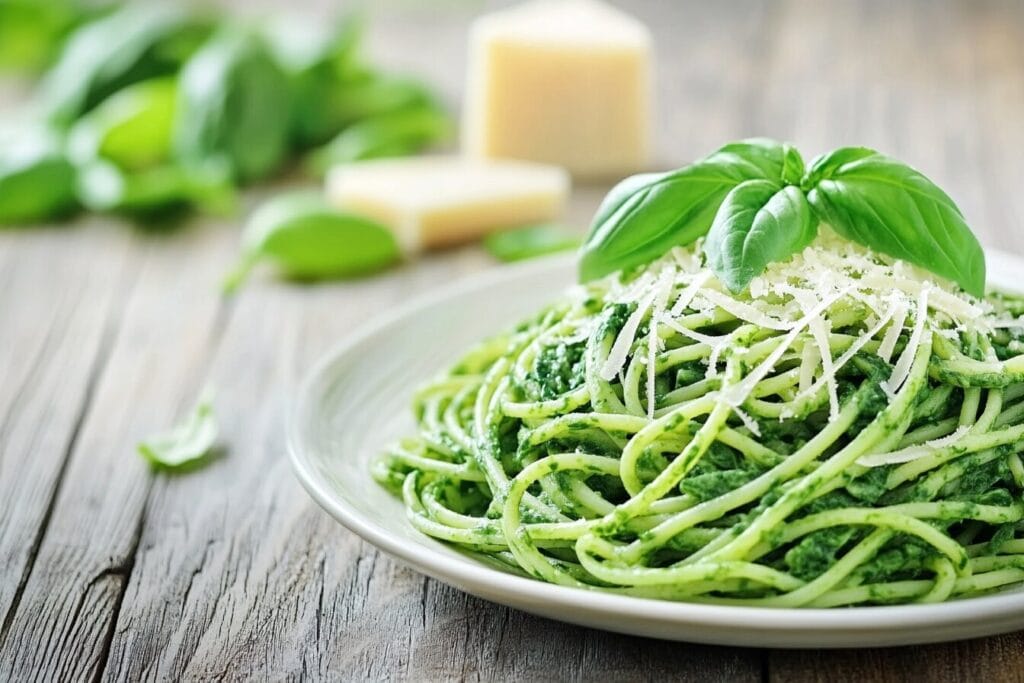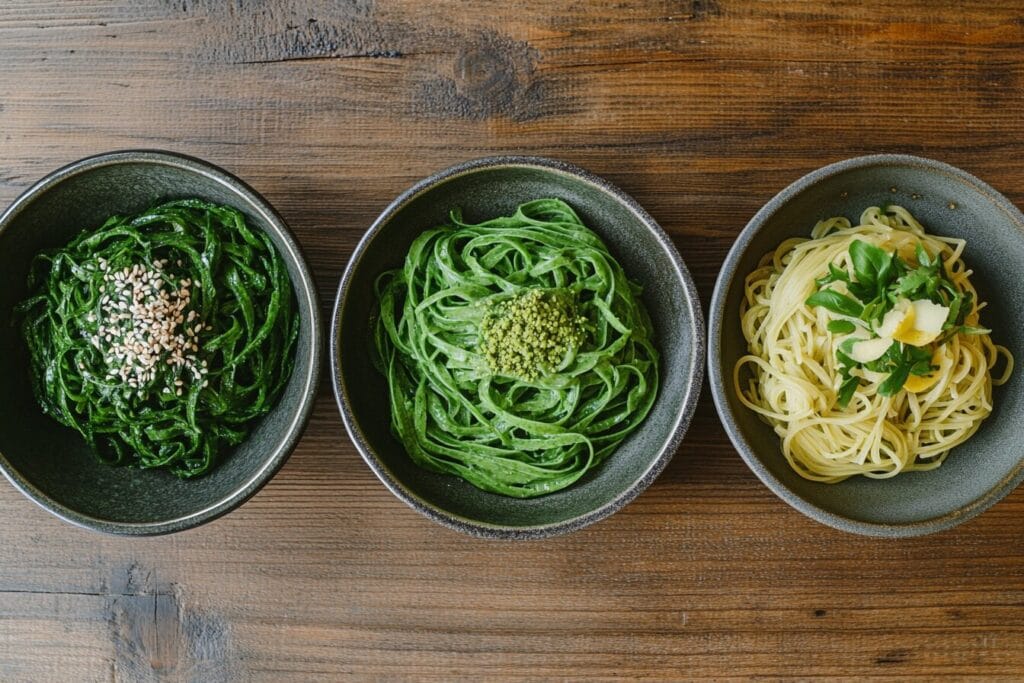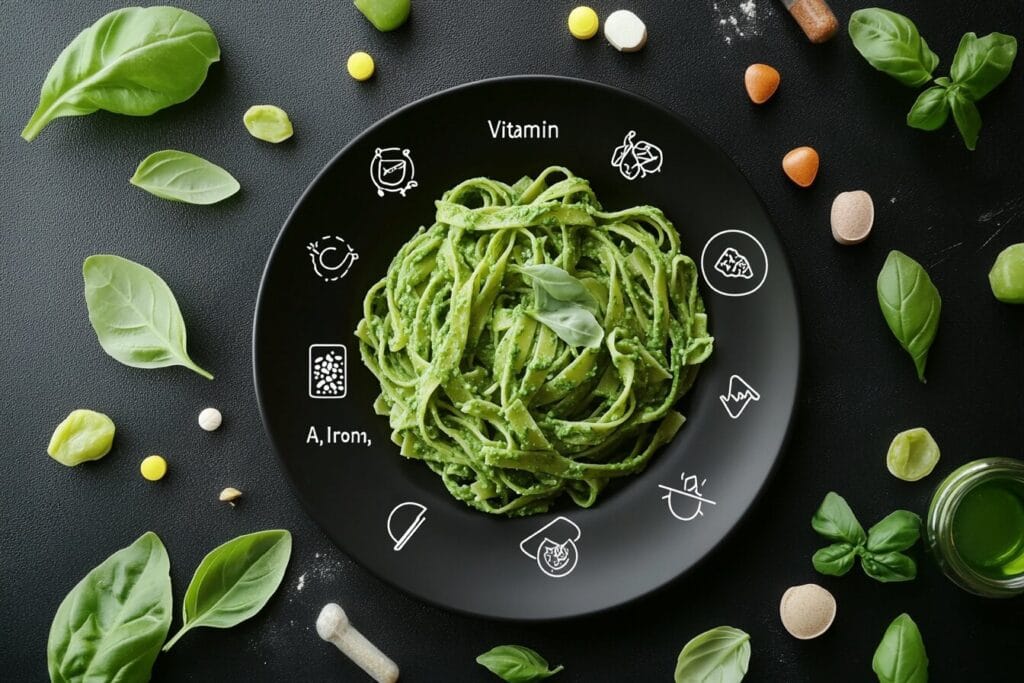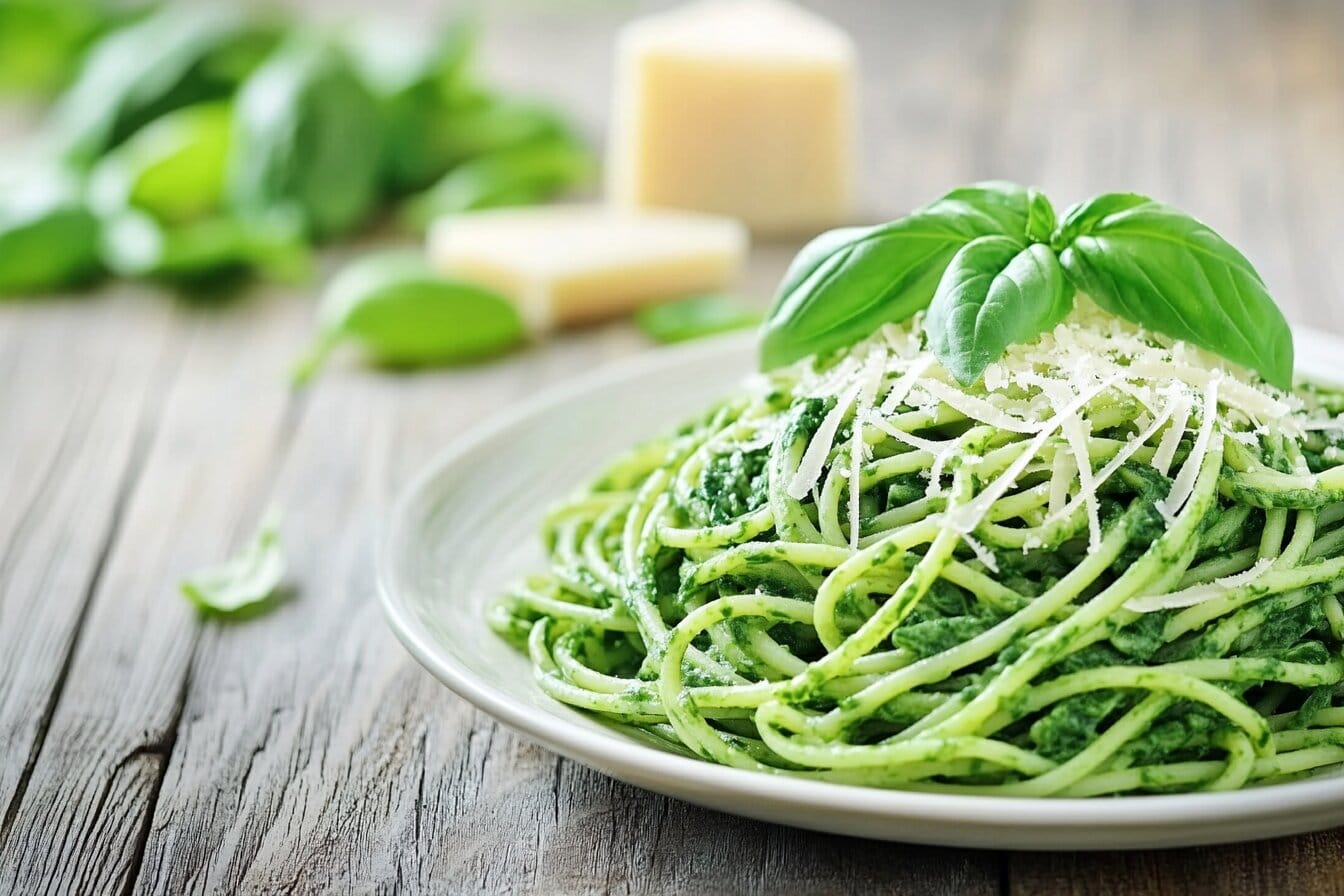Green pasta has intrigued food lovers for decades with its vibrant color and distinctive flavor. Unlike traditional pasta, green pasta owes its hue to the incorporation of nutrient-rich ingredients like spinach, basil, spirulina, or even matcha. These ingredients also influence its taste, resulting in a unique blend of earthy, herbaceous, and sometimes umami-rich notes.
Originating as a culinary innovation in Italian kitchens, green pasta has expanded across cultures and cuisines, offering endless possibilities for creative cooking. Its versatility pairs beautifully with a variety of sauces and seasonings, making it a favorite for chefs and home cooks alike.
But what does it actually taste like? The answer depends on its key ingredients and how it’s prepared. In this article, we’ll explore the flavor profiles of green pasta, the impact of its ingredients, regional varieties, and pairing suggestions to help you understand why it’s celebrated by so many. Whether you’re a food enthusiast or just curious, this deep dive will help you unravel the mystery behind green pasta’s taste.

Ingredients Behind Green Pasta
The flavor of green pasta is rooted in its ingredients, which not only give it its striking color but also contribute significantly to its taste. From the earthy richness of spinach to the aromatic zest of basil and even the bold umami of spirulina or matcha, each component brings a unique character to this culinary delight.
Spinach and Its Earthy Flavor
Spinach is perhaps the most common ingredient in green pasta, especially in Italian cuisine. Its mild, earthy flavor is subtle and doesn’t overpower the dish. Instead, it complements other elements, whether the pasta is served with a light olive oil dressing or a hearty cream-based sauce.
When incorporated into the pasta dough, spinach imparts a fresh, slightly grassy taste that balances well with traditional Mediterranean ingredients like garlic, lemon, and Parmesan cheese. Fresh spinach pasta, in particular, is known for its delicate texture and natural flavor, making it a favorite in dishes like spinach tagliatelle or lasagna verde.
Basil and Herbaceous Notes
Basil is another popular ingredient in green pasta, especially when infused in Italian recipes. Known for its sweet and slightly peppery profile, basil contributes an herbaceous aroma and taste to the pasta. This ingredient often forms the foundation for classic green sauces like pesto, which enhances its flavor with garlic, pine nuts, and Parmesan.
Basil-based green pasta is bright and refreshing, making it an ideal choice for summer dishes. Pair it with cherry tomatoes, fresh mozzarella, and a drizzle of extra virgin olive oil for a vibrant meal that celebrates the best of Italian flavors.
Matcha or Spirulina Variants
For a modern twist, some chefs experiment with matcha or spirulina to create green pasta. These ingredients lend a distinct flavor profile:
- Matcha: This finely ground green tea powder adds a subtle, bittersweet taste to pasta. Popular in Asian fusion cuisine, matcha-based pasta is often served with soy-based sauces, mushrooms, or seafood to enhance its umami characteristics.
- Spirulina: Made from algae, spirulina gives pasta a unique marine-like flavor that pairs well with citrusy and tangy components. It’s a bold choice, particularly for health-focused dishes, as it’s packed with nutrients like protein, iron, and antioxidants.
These variants demonstrate the versatility of green pasta and its ability to adapt to diverse cuisines and palates.
How the Ingredients Influence Flavor
The taste of green pasta is not only defined by its ingredients but also by how those ingredients are prepared and paired. From fresh versus dried varieties to the sauces and spices used in its preparation, the flavor profile of green pasta can vary widely.
Fresh vs. Dried Green Pasta
The texture and flavor of green pasta differ significantly depending on whether it’s fresh or dried.
- Fresh Green Pasta: Fresh pasta is often made with spinach or basil blended directly into the dough. This results in a delicate, smooth texture and a flavor that highlights the natural earthiness or herbaceousness of the green ingredients. Fresh green pasta pairs exceptionally well with light sauces, such as a simple garlic and olive oil dressing or a lemon butter sauce.
- Dried Green Pasta: In contrast, dried green pasta often has a more robust and concentrated flavor due to its longer preparation and dehydration process. It’s slightly firmer and works beautifully with bold sauces like tomato-based marinara, creamy Alfredo, or spiced arrabbiata. Dried pasta also tends to have a more prominent wheat flavor that complements the green ingredients.
Cooking with Garlic and Olive Oil
One of the simplest yet most flavorful ways to prepare green pasta is with garlic and olive oil. This classic Mediterranean combination enhances the subtle flavors of spinach or basil without overpowering them. The result is a harmonious dish where the green pasta’s freshness shines through, complemented by the savory depth of garlic and the richness of high-quality olive oil.
For an added kick, ingredients like crushed red pepper flakes or freshly grated Parmesan can be sprinkled on top. This minimalist approach allows the inherent flavors of the pasta to take center stage.
Creamy Sauces vs. Tomato-Based Sauces
The type of sauce used with green pasta has a significant impact on its taste:
- Creamy Sauces: Pairing green pasta with creamy sauces, such as Alfredo or a mascarpone-based dressing, creates a luxurious dish with a mellow, rich flavor. These sauces blend seamlessly with spinach or basil-based pasta, providing a balanced and indulgent experience.
- Tomato-Based Sauces: On the other hand, tomato-based sauces add tanginess and a slight acidity that contrast beautifully with the mild, earthy flavors of green pasta. The combination of sweet tomatoes and fresh herbs like oregano and basil creates a vibrant dish that highlights the pasta’s herbal undertones.
Both approaches offer delicious ways to enjoy green pasta, depending on your mood and preferences.
Regional Varieties of Green Pasta
Green pasta has evolved across cultures, with each region adding its own flair and flavor profile to this vibrant dish. From Italy’s traditional recipes to Asian influences and American health-focused adaptations, green pasta offers a world of taste possibilities.

Italian Classics: Spinach Tagliatelle
In Italy, green pasta is deeply rooted in traditional cuisine, often made with spinach or basil. One of the most iconic examples is spinach tagliatelle, a flat, ribbon-like pasta that hails from Emilia-Romagna.
- Flavor Profile: Spinach tagliatelle has a mild, earthy taste with a fresh undertone, making it an ideal match for both meat-based sauces like Bolognese and lighter options like sage butter.
- Cultural Significance: This dish is a staple at Italian family gatherings, reflecting the country’s love for simplicity and seasonal ingredients. It’s often served with grated Parmigiano-Reggiano, enhancing the pasta’s delicate flavor.
Asian Green Pasta Inspirations
Green pasta has also found a place in Asian cuisine, particularly with the use of matcha and other green ingredients:
- Matcha Soba Noodles: Japanese cuisine incorporates green tea into soba noodles, giving them a mild, bittersweet taste with earthy undertones.Chefs often serve these noodles cold with a soy-based dipping sauce or in a warm broth topped with seaweed, tofu, and scallions.
- Spinach-Based Ramen: In modern Japanese and Korean fusion dishes, spinach-infused ramen noodles offer a twist on traditional recipes. Their soft, chewy texture pairs wonderfully with rich broths, such as miso or pork bone-based tonkotsu.
These Asian adaptations demonstrate how green pasta can integrate into diverse culinary traditions while maintaining its unique charm.
American Fusion: Spirulina Pasta
In the United States, green pasta has become popular in health-conscious communities, with spirulina emerging as a trendy ingredient.
- Flavor Profile: Spirulina pasta has a distinct, oceanic flavor reminiscent of seaweed. While it may be an acquired taste for some, it pairs well with zesty, citrusy ingredients like lemon and dill to balance its marine-like notes.
- Spirulina pasta appeals to health-conscious individuals for its high protein content, abundance of antioxidants, and essential minerals. Vegans and those seeking nutrient-dense meals often choose it as a favorite option.
American chefs frequently experiment with spirulina pasta by blending it with non-traditional ingredients like avocado cream or roasted vegetables, creating visually stunning and flavorful dishes.
Nutritional Benefits of Green Pasta
Green pasta impresses with its vibrant color, intriguing taste, and remarkable nutritional profile. Ingredients such as spinach, basil, spirulina, or matcha supply essential nutrients, making it a healthier alternative to traditional pasta. These components not only enhance its visual appeal but also ensure a satisfying meal packed with health benefits.

Rich in Antioxidants
Green pasta ingredients provide a wealth of antioxidants, which combat free radicals in the body and promote overall health.
- Spinach delivers high levels of beta-carotene, lutein, and zeaxanthin, protecting against oxidative stress and supporting eye health.
- Basil contributes flavonoids and essential oils, which add anti-inflammatory benefits to green pasta.
- Matcha and Spirulina serve as antioxidant powerhouses. Matcha offers catechins, while spirulina supplies phycocyanin, both boosting health significantly.
These antioxidants not only contribute to overall well-being but also support skin health, boost the immune system, and promote longevity.
Vitamins and Minerals
Green pasta is loaded with essential vitamins and minerals, thanks to its plant-based components. Some of the key nutrients include:
- Iron and Folate: Spinach and spirulina are excellent sources of iron, which supports red blood cell production, and folate, which aids in DNA synthesis and repair.
- Vitamin A and C: These vitamins are abundant in spinach and basil, helping maintain healthy skin, vision, and immune function.
- Calcium and Magnesium: These minerals, often found in spirulina and spinach, contribute to strong bones and muscle function.
Compared to traditional pasta made solely from wheat, green pasta offers a more nutrient-dense option, especially for those looking to enhance their dietary intake of vitamins and minerals.
Low-Calorie and Vegan Options
For those seeking healthier meal options, green pasta can be an excellent choice.
- Low-Calorie: Green pasta made with spinach or basil typically contains fewer calories than pasta made with refined flour, especially when paired with light sauces.
- Vegan-Friendly: Many green pasta recipes avoid eggs and dairy, making them ideal for plant-based diets. Ingredients like spirulina and matcha add both flavor and nutrition without compromising vegan principles.
Health-conscious individuals and fitness enthusiasts often choose green pasta for its combination of flavor, versatility, and nutritional value.
FAQs
Does green pasta taste like regular pasta?
Green pasta delivers a more complex flavor compared to regular pasta. Traditional pasta offers a neutral, wheat-based taste, but green pasta introduces subtle earthy, herbaceous, or umami-rich notes based on its ingredients. Spinach-based pasta provides a mild, earthy flavor, while basil-infused varieties exude a more aromatic profile. When chefs incorporate matcha or spirulina, the pasta develops bittersweet or marine-like undertones.
Can kids enjoy green pasta?
Yes! Green pasta can be an excellent way to introduce kids to nutrient-rich ingredients like spinach and basil in a fun, visually appealing form. Many children enjoy its vibrant color, and when paired with familiar sauces like cheese or tomato, green pasta can become a household favorite. For pickier eaters, a creamy Alfredo sauce can mask the more distinct herbal flavors while still delivering the benefits of green pasta.
What’s the best sauce for green pasta?
The best sauce for green pasta depends on its base ingredient and your personal preference.
- Spinach-based pasta pairs well with light sauces like garlic and olive oil or a creamy Alfredo sauce.
- Basil-infused pasta is ideal for pesto or tomato-based sauces.
- Matcha or spirulina pasta works best with tangy, citrus-based dressings or soy-based sauces to balance their unique flavors.
Experimenting with different pairings can help you find the perfect match.
Does the color affect the taste?
While the vibrant green color of the pasta may not directly alter the taste, it can influence perception. Studies show that food appearance plays a significant role in how we experience flavor. The bright green hue often suggests freshness, making dishes feel lighter and more appealing. That said, the actual flavor depends on the ingredients used to create the color.
Is green pasta healthier than regular pasta?
Green pasta often provides a healthier alternative to regular pasta, especially when chefs use nutrient-dense ingredients like spinach, basil, or spirulina. It delivers higher levels of vitamins, minerals, and antioxidants while offering fewer calories. However, the preparation methods and sauce choices significantly influence its overall health benefits.
Conclusion
Green pasta offers more than just a colorful twist on a classic dish—it delivers a culinary experience that combines flavor, nutrition, and versatility. Ingredients like spinach, basil, matcha, or spirulina create its unique taste, ranging from earthy and herbaceous to subtly sweet or umami-rich. These varied flavor profiles make green pasta pair seamlessly with a variety of sauces, such as creamy Alfredo, tangy tomato, or soy-based dressings.
Beyond its taste, green pasta provides impressive health benefits. Its ingredients deliver vitamins, minerals, and antioxidants, making it a nutrient-packed addition to traditional Italian recipes, modern Asian-inspired dishes, or health-focused meals.
When you encounter green pasta, embrace the opportunity to try it. Its vibrant appearance and intriguing flavors may become your new favorite take on this beloved staple.

